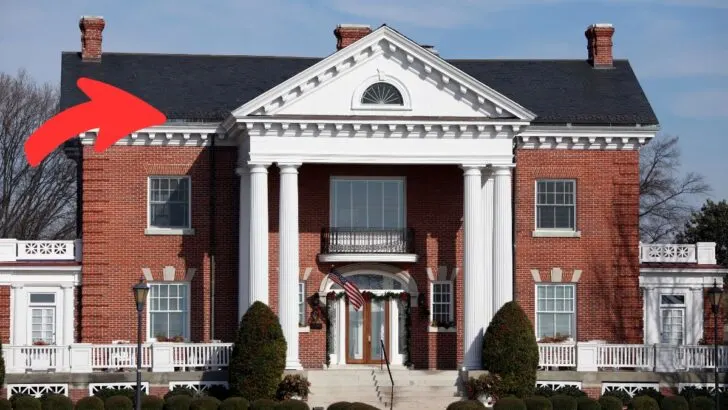Colonial style homes have been a popular architectural style in the United States since the 1600s. They were originally built by European settlers who brought with them the design principles and building techniques of their home countries.
Over time, the colonial style evolved and was adapted to suit the needs and tastes of American homeowners.
Today, colonial style homes remain a popular choice for those looking to buy or build a new home! They are known for their classic, timeless look and their ability to blend seamlessly into any neighborhood.
If you’re considering a colonial style home, it’s important to understand the defining features of this architectural style and how to incorporate them into your own home design.
History of Colonial Homes
Colonial Era Architecture
The Colonial era in America spanned from the late 1600s to the mid-1700s. During this period, the architecture of homes in the colonies was heavily influenced by European styles, particularly those of England and France.
The earliest Colonial homes were simple, one-room structures made of wood or brick, with thatched roofs and small windows.
Over time, the style evolved to include more elaborate designs, such as the Georgian and Federal styles.
Features of Colonial Homes
One of the defining features of Colonial homes is their symmetry. They typically have a central entrance with evenly spaced windows on either side.
The roofs are steeply pitched and often feature dormer windows. The exteriors are usually made of brick or wood, with simple, clean lines and minimal ornamentation.
Inside, Colonial homes are characterized by their practicality and simplicity.
They often have a central hallway with rooms on either side, and the layout is designed to maximize natural light and ventilation. The rooms are typically small and cozy, with fireplaces as the focal point.
Other features commonly found in Colonial homes include:
- Paneled doors and wainscoting
- Built-in cabinetry and shelving
- Hardwood floors
- Exposed ceiling beams
- Staircases with simple, elegant balustrades
Overall, Colonial homes are known for their timeless elegance and practicality.
They continue to be a popular architectural style today, with many homeowners seeking to replicate the classic look and feel of these historic homes.
Types of Colonial Homes
Colonial-style homes were built in America between the 1600s and the mid-1800s. They were inspired by European architectural styles and adapted to suit the needs of the new world.
Over time, several distinct types of colonial homes emerged, each with its unique features and characteristics.
1. Georgian Colonial
The Georgian Colonial style was popular during the 18th century. It was characterized by symmetrical facades, central entrances, and evenly spaced windows.
The style was named after King George I, who reigned in England from 1714 to 1727. Georgian Colonial homes were typically built with brick or stone and featured elaborate decorative details, such as dentil molding and pediments.
2. Federal Colonial
The Federal Colonial style emerged in the late 18th century and was popular until the early 19th century. It was characterized by a more restrained and formal design than the Georgian Colonial style.
Federal Colonial homes featured flat roofs, simple moldings, and delicate decorative details, such as swags and urns.
They were often built with brick or clapboard siding and featured fanlights and sidelights around the front door.
3. Dutch Colonial
The Dutch Colonial style was popular in the mid-1700s. It was characterized by a gambrel roof, which had two slopes on each side, with the lower slope being steeper than the upper slope.
Dutch Colonial homes were typically built with brick or stone and featured large chimneys and dormer windows. They were often decorated with shutters and flower boxes.
4. Spanish Colonial
The Spanish Colonial style was popular in the Southwest and Florida during the 1600s and 1700s. It was characterized by stucco walls, red tile roofs, and wrought-iron balconies.
Spanish Colonial homes were often built around a central courtyard and featured arched doorways and windows. They were decorated with colorful tiles and ornate ironwork.
5. Cape Cod Colonial
The Cape Cod Colonial style emerged in the late 1600s and was popular until the mid-1800s. It was characterized by a simple, symmetrical design and a steeply pitched roof with gables on each end.
Cape Cod Colonial homes were typically built with wood and featured shutters and a central chimney. They were often decorated with a white picket fence and a small garden.
Characteristics of Colonial Style Homes
Exterior Features
Colonial style homes are known for their symmetrical and balanced appearance. They typically have a rectangular shape with a steep, pitched roof and a centered front door.
The exterior is usually made of brick or wood, with decorative shutters and a prominent chimney.
Other common exterior features include:
- Double-hung windows
- Dormer windows
- Portico or porch with columns
- Multi-pane windows
- Decorative moldings
Interior Features
The interior of a Colonial style home is equally as impressive as the exterior. The layout is typically formal and organized, with a central hallway and symmetrical rooms on either side.
Other common interior features include:
- Fireplace in the living room
- Hardwood floors
- Wainscoting and crown molding
- Staircase in the entryway
- Formal dining room
Overall, Colonial style homes are timeless and elegant. They are a popular choice for homeowners who appreciate traditional design and classic features.
Section 5: Decorating Colonial Style Homes
Furniture and Decor
When it comes to decorating Colonial style homes, furniture and decor play a crucial role in creating the desired look and feel.
Traditional furniture pieces like wingback chairs, roll-arm sofas, and four-poster beds are perfect for achieving the Colonial style. Look for furniture made of wood, such as oak, mahogany, or maple, and opt for pieces with intricate carvings and details.
In addition to furniture, decor elements like antique rugs, vintage paintings, and decorative mirrors can add a touch of elegance and sophistication to your Colonial style home.
Displaying decorative plates or antique china on shelves or in cabinets can also add a sense of history and charm to your space.
Color Palettes
Choosing the right color palette is essential when decorating Colonial style homes. The Colonial style is known for its warm, earthy tones, including shades of brown, beige, and cream.
To add depth and interest to your space, consider incorporating darker shades of green or blue.
When selecting colors for your Colonial style home, it’s important to stick to a cohesive color scheme throughout the space. Consider using accent colors sparingly, such as in throw pillows or decorative accessories, to avoid overwhelming the space.
Overall, decorating a Colonial style home requires attention to detail and a focus on traditional elements. By incorporating classic furniture pieces and warm, earthy tones, you can create a space that is both inviting and timeless.
Maintaining Colonial Style Homes
Exterior Maintenance Tips
Colonial style homes are known for their classic elegance and timeless beauty. To keep your home looking its best, it’s important to maintain the exterior regularly.
Here are some helpful tips!
- Inspect the roof and gutters twice a year and clean them as needed.
- Check for any cracks or damage to the foundation and repair as necessary.
- Power wash the exterior siding and trim every two to three years to remove dirt and grime.
- Repaint the exterior every five to ten years to maintain the classic look of your home.
- Trim trees and bushes away from the house to prevent damage from falling branches or leaves.
Interior Maintenance Tips
The interior of a colonial style home is just as important as the exterior.
Here are some tips to keep your home looking its best:
- Clean and dust regularly to prevent buildup of dirt and allergens.
- Replace air filters every three to six months to maintain good air quality.
- Check for any leaks or water damage and repair as necessary.
- Inspect and maintain the HVAC system annually to ensure it’s functioning properly.
- Replace any worn or outdated fixtures, such as light switches or faucets, to maintain a classic look.
By following these maintenance tips, you can keep your colonial style home looking beautiful and timeless for years to come.
Pros and Cons of Owning a Colonial Style Home
Pros
There are many advantages to owning a colonial style home:
- Historic Charm: Colonial style homes are known for their classic, timeless design. They often feature symmetrical facades, elegant entryways, and traditional details like shutters and dormer windows.
- Spacious Layout: Colonial homes typically have a spacious, open floor plan with large living areas and plenty of bedrooms. This makes them ideal for families or anyone who likes to entertain.
- Good Resale Value: Because of their popularity and historic charm, colonial style homes tend to hold their value well. This makes them a good investment for homeowners who may want to sell in the future.
- Energy Efficiency: Many modern colonial style homes are built with energy-efficient features like insulated windows and doors, which can help lower your utility bills.
Cons
Despite their many advantages, there are also some potential downsides to owning a colonial style home:
- Expensive Upkeep: Because of their historic nature, colonial homes may require more maintenance and upkeep than newer homes. This can be costly, especially if you need to replace or repair original features like windows or roofing.
- Less Privacy: Colonial homes often have a symmetrical layout, which means that bedrooms and other living spaces may be located close to each other. This can make it difficult to find quiet, private spaces in the home.
- Less Natural Light: Traditional colonial homes often have smaller windows and darker interiors, which can make them feel less bright and airy than modern homes.
Frequently Asked Questions on Colonial Style Home
Types of Colonial Homes
When it comes to colonial-style homes, there are several different types to choose from. From the grand Georgian homes of the East Coast to the charming Dutch Colonials of the Midwest, each type has its own unique features and design elements.
To learn more about the different types of colonial homes, check out my comprehensive guide to types of colonial homes.
Colonial vs Traditional Home
If you’re trying to decide between a colonial-style home and a more traditional style, it can be helpful to understand the key differences between the two.
While both styles have their own unique features, there are some distinct differences in terms of architecture, design, and layout. To learn more, check out my guide to colonial vs. traditional homes.
Are Colonial Homes Cheaper to Build?
If you’re considering building a new home, you may be wondering if a colonial-style home is a more cost-effective option.
While there are some factors that can make colonial homes slightly more expensive to build, there are also ways to save money without sacrificing the classic colonial look. To learn more, check out my guide on are colonial homes are cheaper to build.
How to Update a Colonial Style Home
While colonial-style homes are timeless and classic, they can also benefit from some modern updates to keep them looking fresh and stylish.
From adding a fresh coat of paint to updating the lighting fixtures, there are plenty of ways to update your colonial-style home without losing its charm. To learn more, check out my guide on how to update a colonial-style home.


